A Finite Element Method for Determining the Mechanical Properties of Electrospun Nanofibrous Mats
Abstract
:1. Introduction
2. Materials and Methods
2.1. Materials
2.2. Fabrication of PAN Nanofibers
2.3. Morphology
2.4. Porosity
2.5. Tensile Test
2.6. Defining the Mechanical Properties of a Single Nanofiber
3. Finite Element Model
3.1. Geometric Modeling
- All fibers are initially generated with their midpoint located at the center of the domain area.
- Each fiber is then rotated at a random angle ranging from −90 to +90 degrees, with the fiber length extending to the boundaries of the domain.
- For oriented nanofibers, the angle of fiber rotation is precisely controlled to reflect their aligned structure.
- All fibers extend to the end of the domain.
- All fibers have an equal diameter.
- All fibers maintain a straight configuration throughout the domain, without any bending.
- All intersecting fibers are inter-bonded within the domain area.
3.2. Boundary Conditions
3.3. Material Model
4. Results and Discussion
4.1. Morphology
4.2. Experimental Results of the Mechanical Properties of a Nanofiber Mat
4.3. Predicted Stress–Strain Curve of Single Nanofibers
4.4. Convergence and Validation of the Developed FEM Model
4.5. Effect of Structural Parameters on the Strength of the Nanofiber Mat
5. Conclusions
Author Contributions
Funding
Data Availability Statement
Acknowledgments
Conflicts of Interest
References
- Al-abduljabbar, A.; Farooq, I. Electrospun Polymer Nanofibers: Processing, Properties, and Applications. Polymers 2023, 15, 65. [Google Scholar] [CrossRef] [PubMed]
- Xue, J.; Wu, T.; Dai, Y.; Xia, Y. Electrospinning and electrospun nanofibers: Methods, materials, and applications. Chem. Rev. 2019, 119, 5298–5415. [Google Scholar] [CrossRef]
- Anusiya, G.; Jaiganesh, R. A review on fabrication methods of nanofibers and a special focus on application of cellulose nanofibers. Carbohydr. Polym. Technol. Appl. 2022, 4, 100262. [Google Scholar] [CrossRef]
- Sundarrajan, S.; Tan, K.L.; Lim, S.H.; Ramakrishna, S. Electrospun nanofibers for air filtration applications. Procedia Eng. 2014, 75, 159–163. [Google Scholar] [CrossRef]
- Liao, Y.; Loh, C.H.; Tian, M.; Wang, R.; Fane, A.G. Progress in electrospun polymeric nanofibrous membranes for water treatment: Fabrication, modification and applications. Prog. Polym. Sci. 2018, 77, 69–94. [Google Scholar] [CrossRef]
- Lasenko, I.; Sanchaniya, J.V.; Kanukuntla, S.P.; Ladani, Y.; Viluma-gudmona, A.; Kononova, O.; Lusis, V.; Tipans, I.; Selga, T. The mechanical properties of nanocomposites reinforced with PA6 electrospun nanofibers. Polymers 2023, 15, 673. [Google Scholar] [CrossRef]
- Chen, K.; Hu, H.; Zeng, Y.; Pan, H.; Wang, S.; Zhang, Y.; Shi, L.; Tan, G.; Pan, W.; Liu, H. Recent advances in electrospun nanofibers for wound dressing. Eur. Polym. J. 2022, 178, 111490. [Google Scholar] [CrossRef]
- Sun, G.; Sun, L.; Xie, H.; Liu, J. Electrospinning of nanofibers for energy applications. Nanomaterials 2016, 6, 129. [Google Scholar] [CrossRef]
- Gorji, M.; Bagherzadeh, R.; Fashandi, H. Electrospun Nanofibers in Protective Clothing; Elsevier Ltd.: Amsterdam, The Netherlands, 2017; ISBN 9780081009116. [Google Scholar]
- Arun, A.; Malrautu, P.; Laha, A.; Ramakrishna, S. Gelatin nanofibers in drug delivery systems and tissue engineering. Eng. Sci. 2021, 16, 71–81. [Google Scholar] [CrossRef]
- Lasenko, I.; Grauda, D.; Butkauskas, D.; Sanchaniya, J.V.; Viluma-Gudmona, A.; Lusis, V. Testing the physical and mechanical properties of polyacrylonitrile nanofibers reinforced with succinite and silicon dioxide nanoparticles. Textiles 2022, 2, 162–173. [Google Scholar] [CrossRef]
- Jafari, A.; Sadeghi, A. A new insight into the mechanical properties of nanobiofibers and vibrational behavior of atomic force microscope beam considering them as the samples. J. Mech. Behav. Biomed. Mater. 2023, 142, 105842. [Google Scholar] [CrossRef]
- Gachon, E.; Mesquida, P. Mechanical properties of collagen fibrils determined by buckling analysis. Acta Biomater. 2022, 149, 60–68. [Google Scholar] [CrossRef] [PubMed]
- Maccaferri, E.; Cocchi, D.; Mazzocchetti, L.; Benelli, T.; Brugo, T.M.; Giorgini, L.; Zucchelli, A. How Nanofibers Carry the Load: Toward a Universal and Reliable Approach for Tensile Testing of Polymeric Nanofibrous Membranes. Macromol. Mater. Eng. 2021, 306, 2100183. [Google Scholar] [CrossRef]
- Verschatse, O.; Loccufier, E.; Swanckaert, B.; De Clerck, K.; Daelemans, L. Microscale and Macroscale Deformation Behavior of Electrospun Polymeric Nanofiber Membranes Using In Situ SEM during Mechanical Testing. Polymers 2023, 15, 1630. [Google Scholar] [CrossRef] [PubMed]
- Pai, C.L.; Boyce, M.C.; Rutledge, G.C. On the importance of fiber curvature to the elastic moduli of electrospun nonwoven fiber meshes. Polymer 2011, 52, 6126–6133. [Google Scholar] [CrossRef]
- Rizvi, M.S.; Pal, A. Statistical Model for the Mechanical Behavior of the Tissue Engineering Non-Woven Fibrous Matrices under Large Deformation; Elsevier: Amsterdam, The Netherlands, 2014; Volume 37, ISBN 9195321349. [Google Scholar]
- Vatankhah, E.; Semnani, D.; Prabhakaran, M.P.; Tadayon, M.; Razavi, S.; Ramakrishna, S. Artificial neural network for modeling the elastic modulus of electrospun polycaprolactone/gelatin scaffolds. Acta Biomater. 2014, 10, 709–721. [Google Scholar] [CrossRef] [PubMed]
- Yin, Y.; Xiong, J. Finite element analysis of electrospun nanofibrous mats under biaxial tension. Nanomaterials 2018, 8, 348. [Google Scholar] [CrossRef] [PubMed]
- Yin, Y.; Pan, Z.; Xiong, J. A tensile constitutive relationship and a finite element model of electrospun nanofibrous mats. Nanomaterials 2018, 8, 29. [Google Scholar] [CrossRef] [PubMed]
- Farukh, F.; Demirci, E.; Sabuncuoglu, B.; Acar, M.; Pourdeyhimi, B.; Silberschmidt, V.V. Numerical analysis of progressive damage in nonwoven fibrous networks under tension. Int. J. Solids Struct. 2014, 51, 1670–1685. [Google Scholar] [CrossRef]
- Zhang, M.; Chen, Y.; Chiang, F.P.; Gouma, P.I.; Wang, L. Modeling the large deformation and microstructure evolution of nonwoven polymer fiber networks. J. Appl. Mech. Trans. ASME 2019, 86, 011010. [Google Scholar] [CrossRef]
- Kobeissi, A.; Rahme, P.; Leotoing, L.; Guines, D. Strength characterization of glass/epoxy plain weave composite under different biaxial loading ratios. J. Compos. Mater. 2020, 54, 2549–2563. [Google Scholar] [CrossRef]
- Chavoshnejad, P.; Alsmairat, O.; Ke, C.; Razavi, M.J. Effect of interfiber bonding on the rupture of electrospun fibrous mats. J. Phys. D Appl. Phys. 2021, 54, 025302. [Google Scholar] [CrossRef]
- Sanchaniya, J.V.; Lasenko, I.; Kanukuntala, S.-P.; Smogor, H.; Viluma-Gudmona, A.; Krasnikovs, A.; Gobins, V.; Tipans, I. Mechanical and thermal characteristics of annealed-oriented PAN nanofibers. Polymers 2023, 15, 3287. [Google Scholar] [CrossRef]
- Sanchaniya, J.V.; Lasenko, I.; Kanukuntla, S.P.; Mannodi, A.; Viluma-gudmona, A.; Gobins, V. Preparation and Characterization of Non-Crimping Laminated Textile Composites Reinforced with Electrospun Nanofibers. Nanomaterials 2023, 13, 1949. [Google Scholar] [CrossRef] [PubMed]
- Rezakhaniha, R.; Agianniotis, A.; Schrauwen, J.T.C.; Griffa, A.; Sage, D.; Bouten, C.V.C.; Van De Vosse, F.N.; Unser, M.; Stergiopulos, N. Experimental investigation of collagen waviness and orientation in the arterial adventitia using confocal laser scanning microscopy. Biomech. Model. Mechanobiol. 2012, 11, 461–473. [Google Scholar] [CrossRef] [PubMed]
- Püspöki, Z.; Storath, M.; Sage, D.; Unser, M. Transforms and operators for directional bioimage analysis: A survey. Adv. Anat. Embryol. Cell Biol. 2016, 219, 69–93. [Google Scholar] [CrossRef] [PubMed]
- Schneider, C.A.; Rasband, W.S.; Eliceiri, K.W. NIH Image to ImageJ: 25 years of image analysis. Nat. Methods 2012, 9, 671–675. [Google Scholar] [CrossRef]
- ISO 139:2005; Textiles—Standard Atmospheres for Conditioning and Testing. International Organization for Standardization (ISO): Geneva, Switzerland, 2005.
- ASTM D882-18; Standard Test Method for Tensile Properties of Thin Plastic Sheeting. ASTM International: West Conshohocken, PA, USA, 2018.
- Chavoshnejad, P.; Razavi, M.J. Effect of the Interfiber Bonding on the Mechanical Behavior of Electrospun Fibrous Mats. Sci. Rep. 2020, 10, 7709. [Google Scholar] [CrossRef]
- Wei, X.; Xia, Z.; Wong, S.C.; Baji, A. Modelling of mechanical properties of electrospun nanofibre network. Int. J. Exp. Comput. Biomech. 2009, 1, 45. [Google Scholar] [CrossRef]
- Choi, S.S.; Lee, S.G.; Joo, C.W.; Im, S.S.; Kim, S.H. Formation of interfiber bonding in electrospun poly(etherimide) nanofiber web. J. Mater. Sci. 2004, 39, 1511–1513. [Google Scholar] [CrossRef]
- Ridruejo, A.; González, C.; Llorca, J. Micromechanisms of deformation and fracture of polypropylene nonwoven fabrics. Int. J. Solids Struct. 2011, 48, 153–162. [Google Scholar] [CrossRef]
- Chen, N.; Koker, M.K.A.; Uzun, S.; Silberstein, M.N. In-situ X-ray study of the deformation mechanisms of non-woven polypropylene. Int. J. Solids Struct. 2016, 97–98, 200–208. [Google Scholar] [CrossRef]
- Domaschke, S.; Zündel, M.; Mazza, E.; Ehret, A.E. A 3D computational model of electrospun networks and its application to inform a reduced modelling approach. Int. J. Solids Struct. 2019, 158, 76–89. [Google Scholar] [CrossRef]
- Kumar, V.; Rawal, A. Elastic moduli of electrospun mats: Importance of fiber curvature and specimen dimensions. J. Mech. Behav. Biomed. Mater. 2017, 72, 6–13. [Google Scholar] [CrossRef]



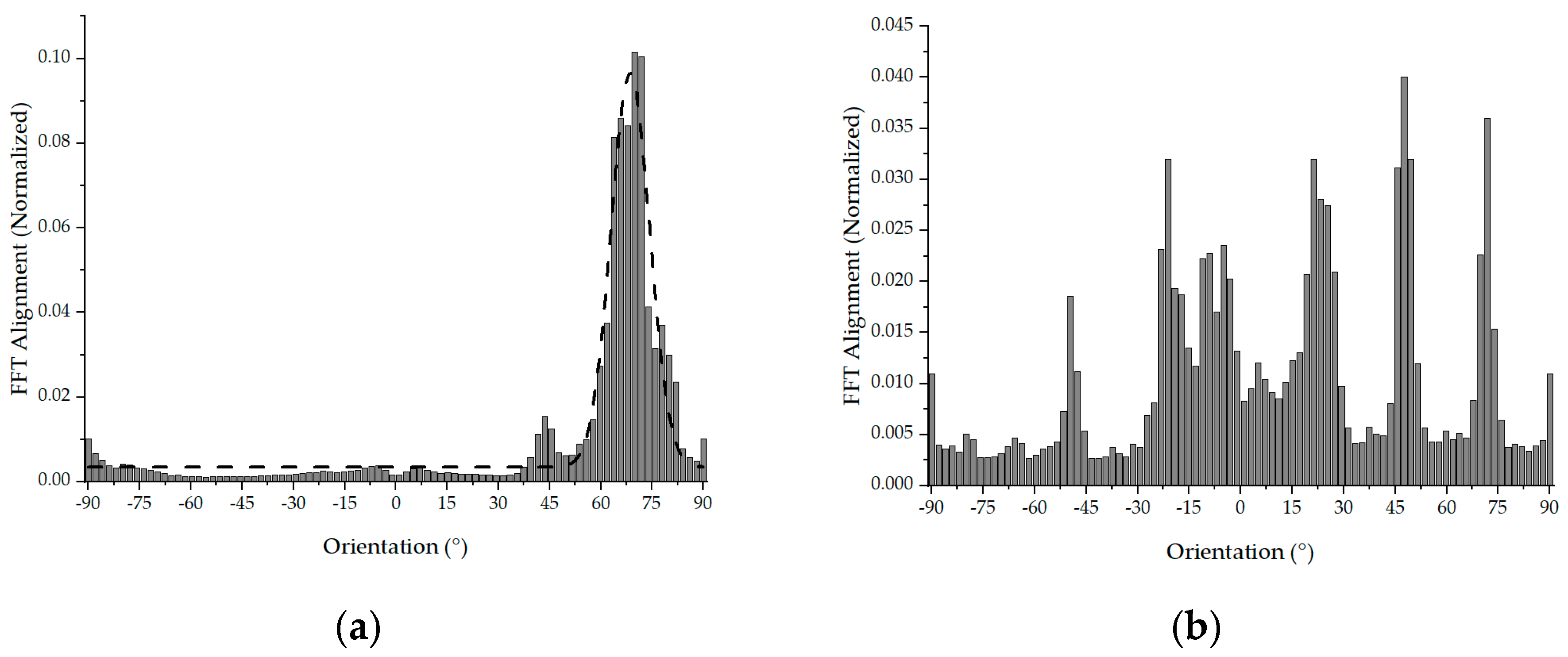

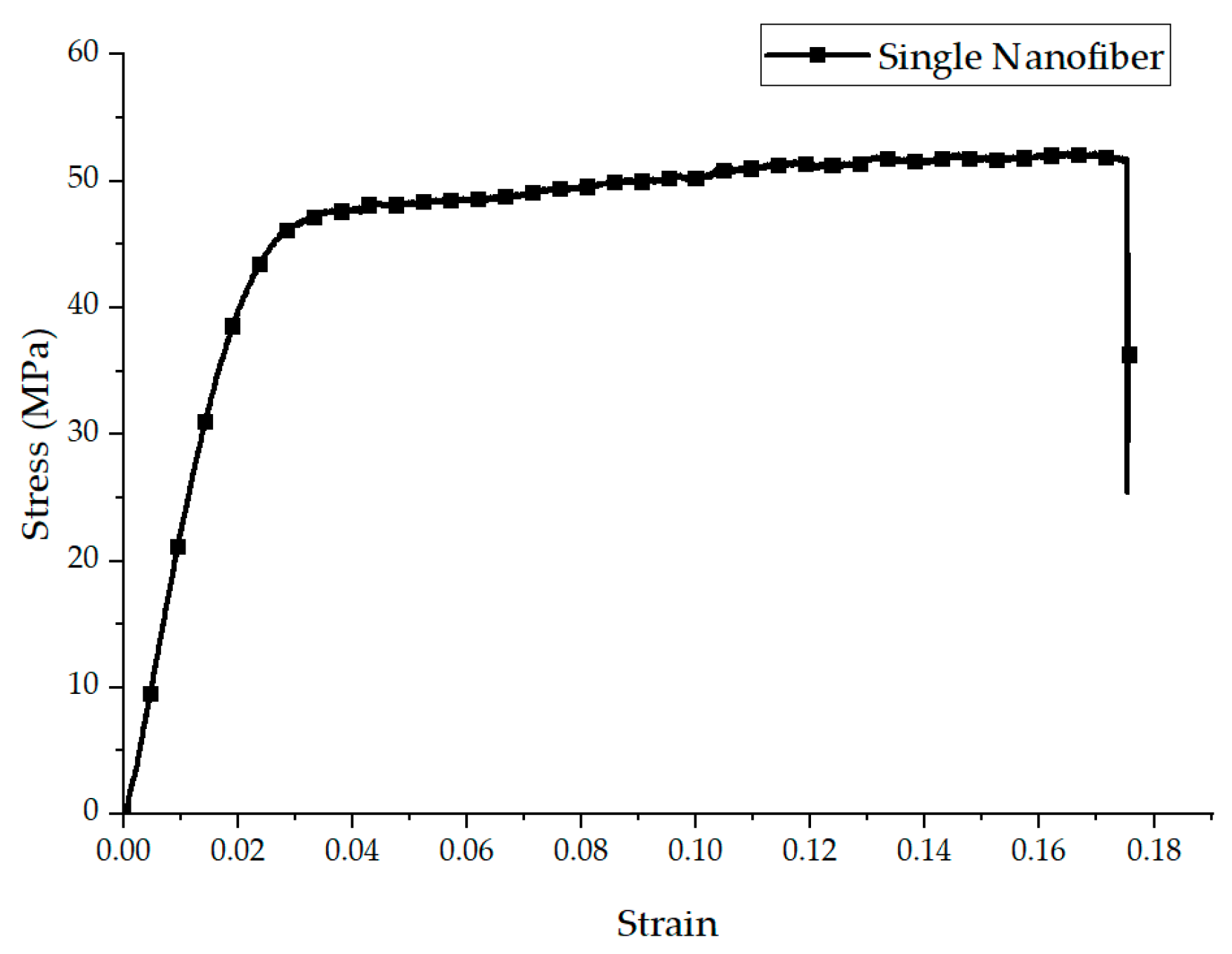

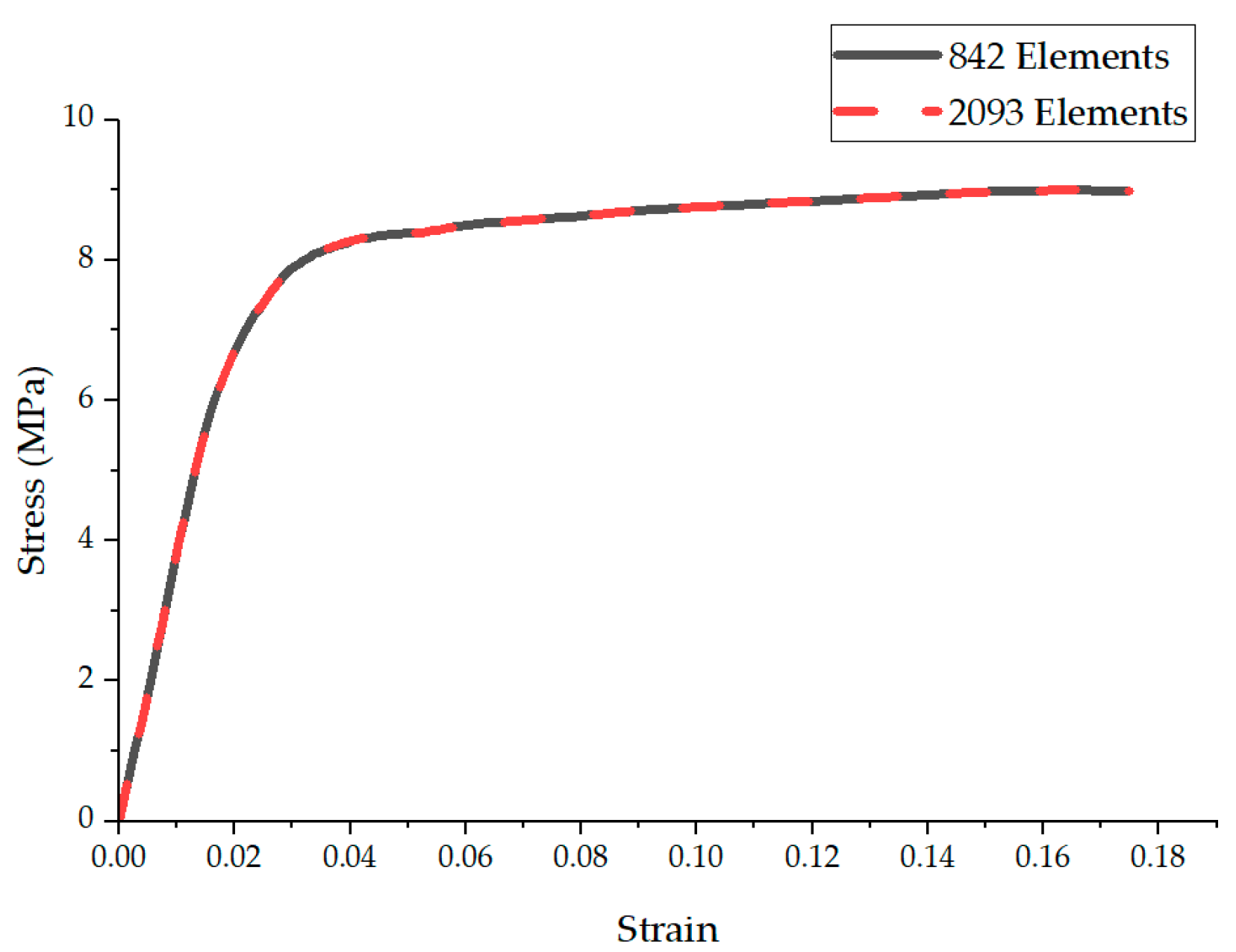

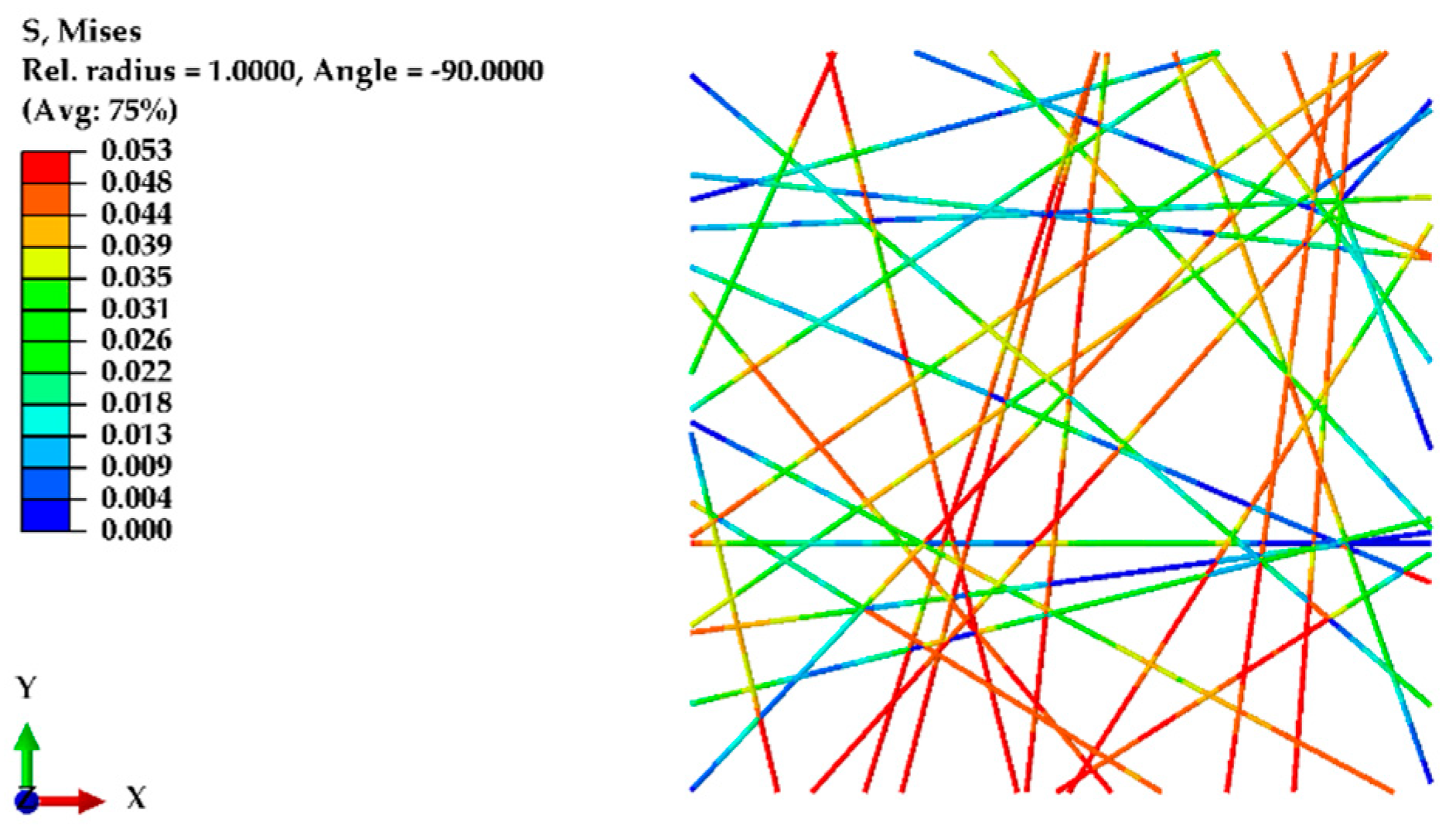

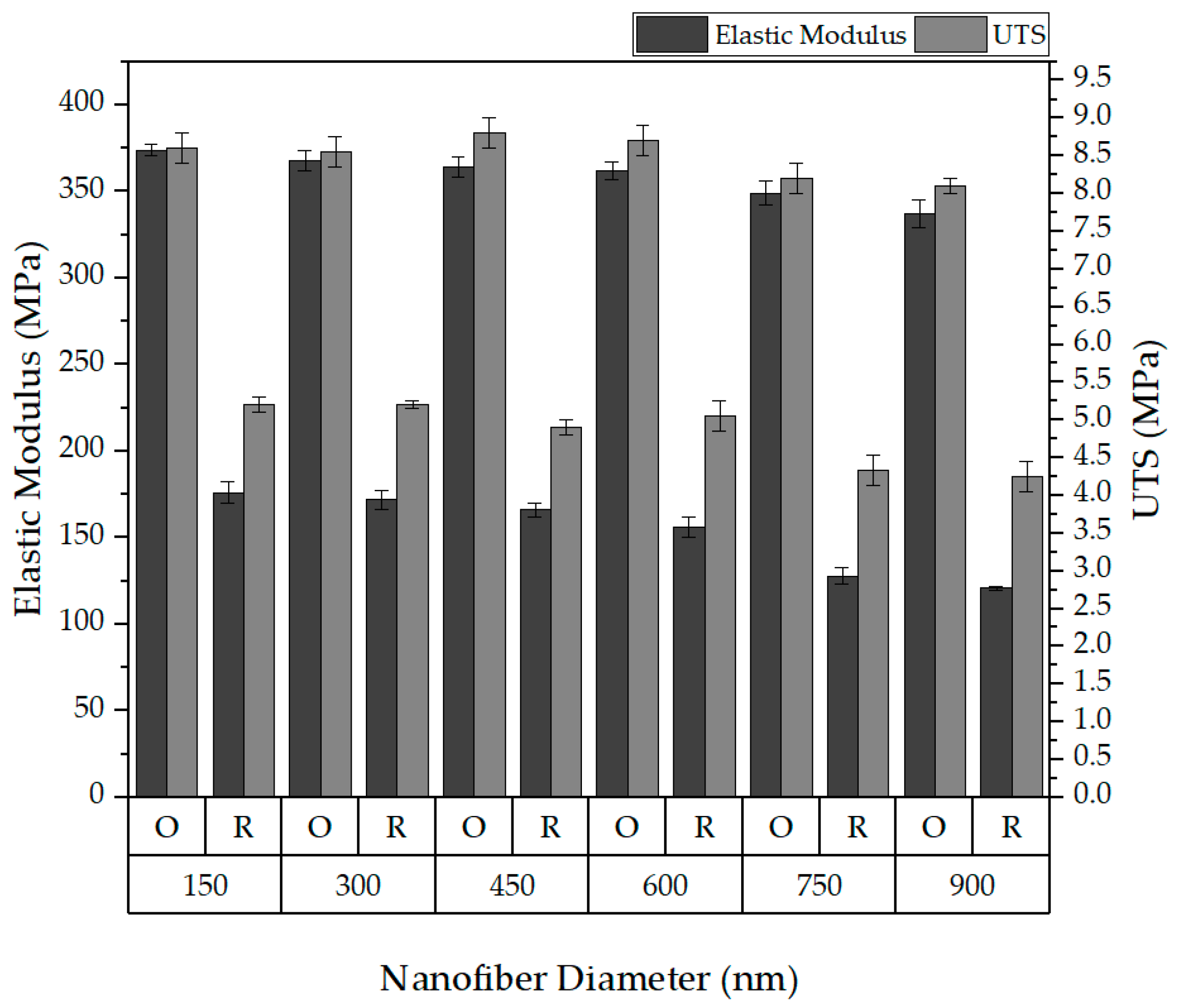
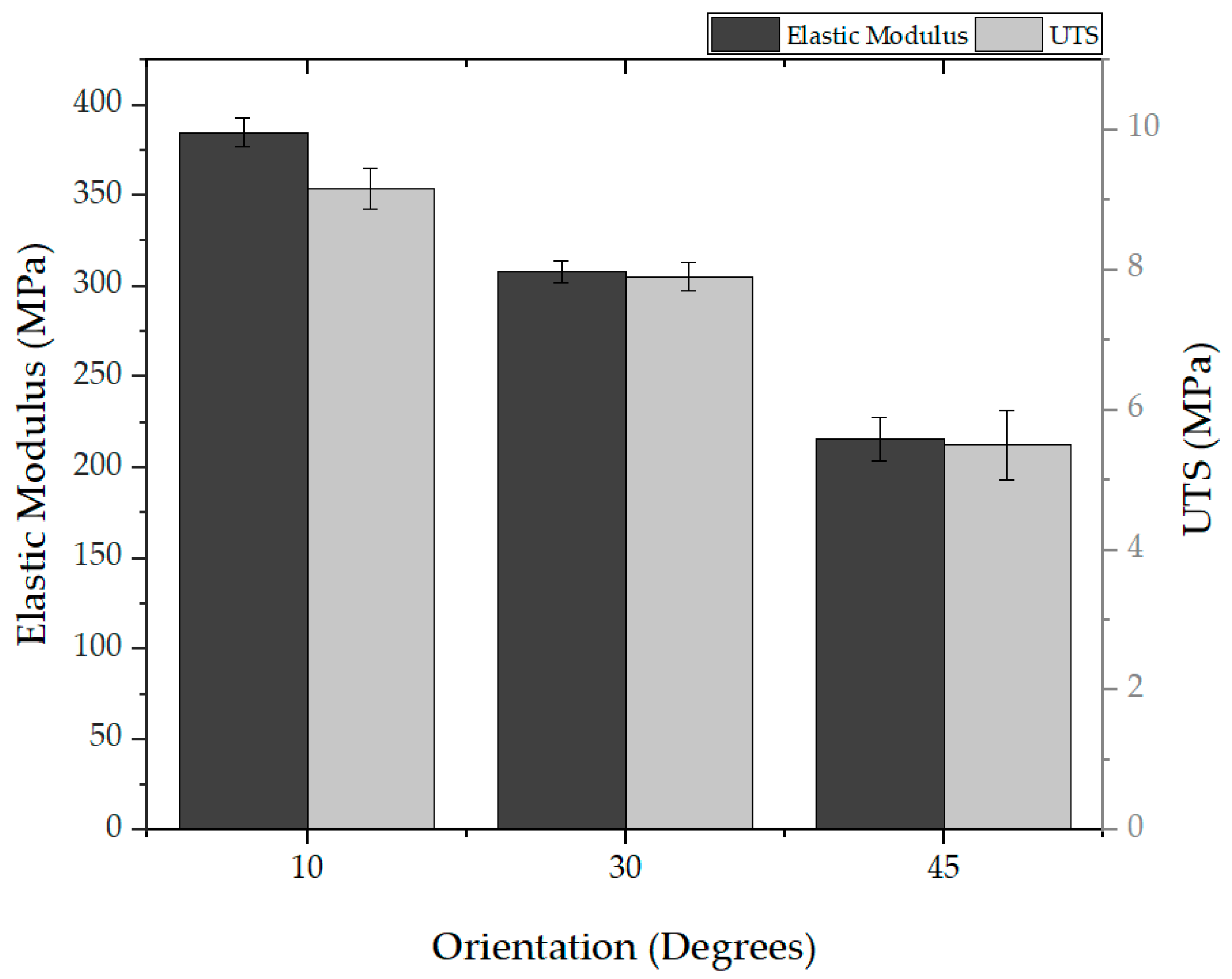
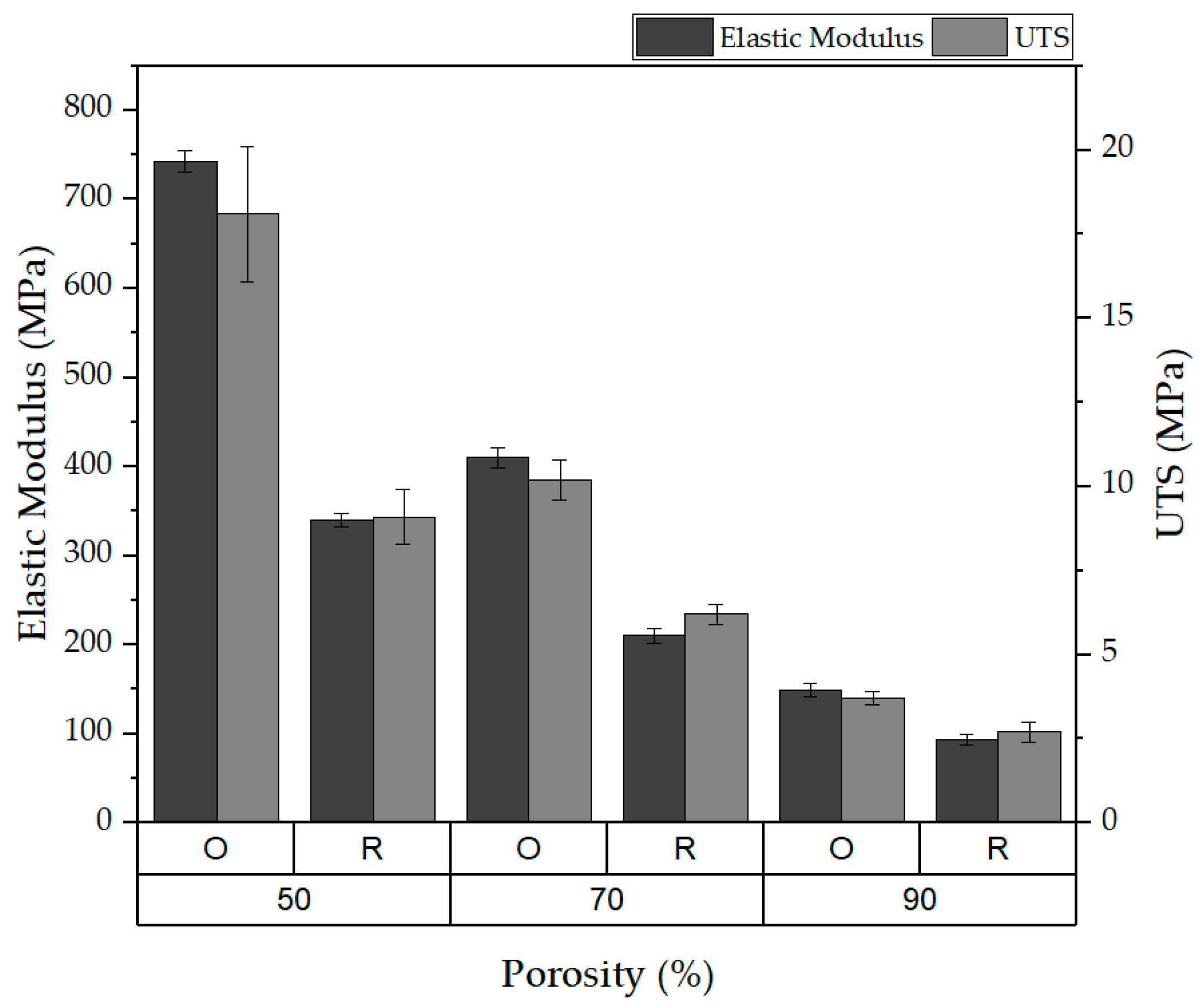
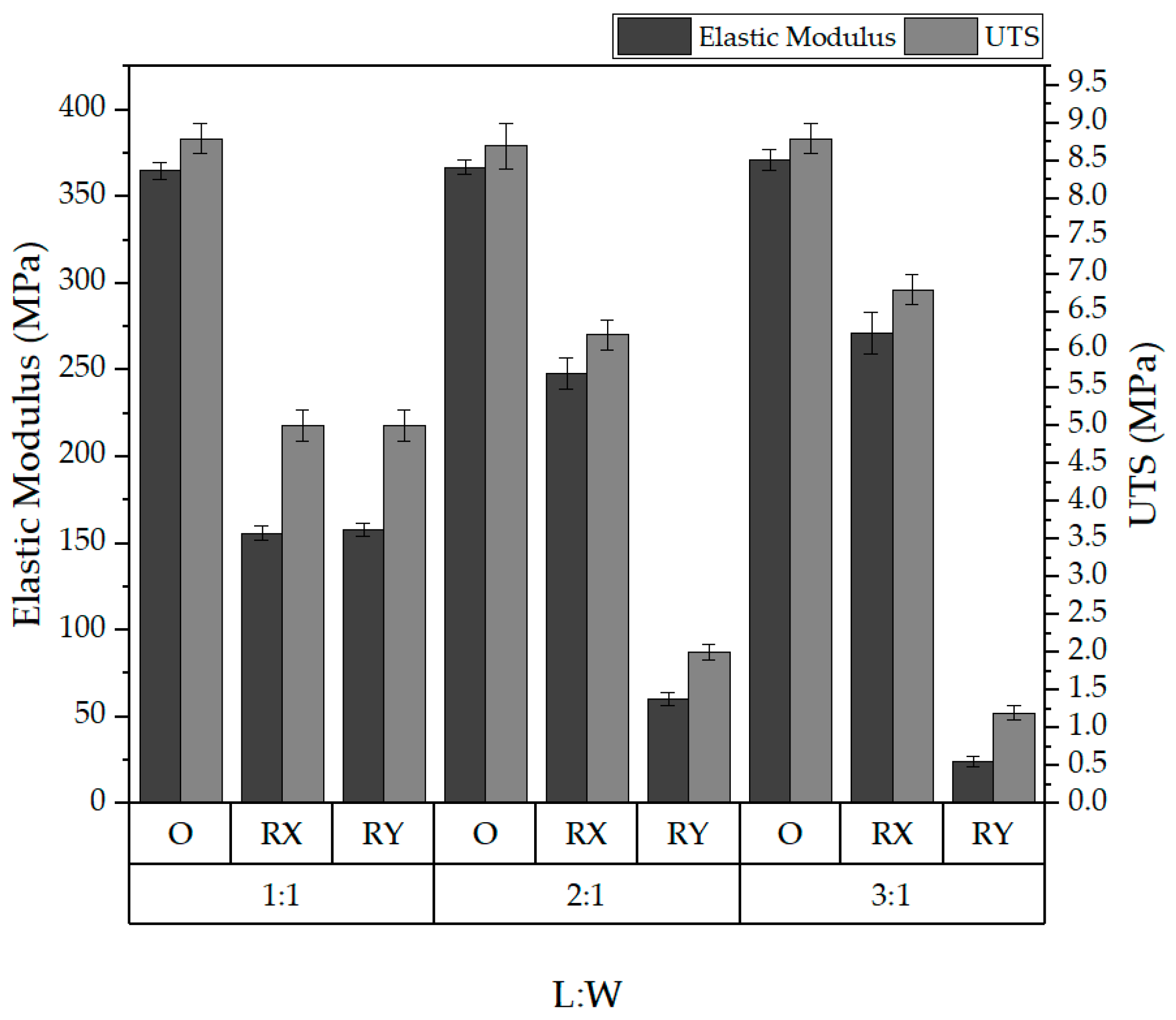
| Structure of Nanofibers | Testing Direction | Thickness, t (µm) | Ultimate Tensile Strength σmax (MPa) | Young’s Modulus, E (MPa) | Elongation at Break Strain, ε |
|---|---|---|---|---|---|
| oriented | longitudinal | 84 ± 4 | 8.9 ± 0.5 | 410 ± 23 | 0.19 ± 0.02 |
| transverse | 83 ± 3 | 1.1 ± 0.1 | 53 ± 5 | 0.2 ± 0.03 | |
| random | longitudinal | 87 ± 5 | 3.9 ± 0.4 | 103 ± 4 | 0.35 ± 0.03 |
| transverse | 85 ± 4 | 4.0 ± 0.5 | 99 ± 5 | 0.36 ± 0.04 |
Disclaimer/Publisher’s Note: The statements, opinions and data contained in all publications are solely those of the individual author(s) and contributor(s) and not of MDPI and/or the editor(s). MDPI and/or the editor(s) disclaim responsibility for any injury to people or property resulting from any ideas, methods, instructions or products referred to in the content. |
© 2024 by the authors. Licensee MDPI, Basel, Switzerland. This article is an open access article distributed under the terms and conditions of the Creative Commons Attribution (CC BY) license (https://creativecommons.org/licenses/by/4.0/).
Share and Cite
Sanchaniya, J.V.; Lasenko, I.; Gobins, V.; Kobeissi, A.; Goljandin, D. A Finite Element Method for Determining the Mechanical Properties of Electrospun Nanofibrous Mats. Polymers 2024, 16, 852. https://doi.org/10.3390/polym16060852
Sanchaniya JV, Lasenko I, Gobins V, Kobeissi A, Goljandin D. A Finite Element Method for Determining the Mechanical Properties of Electrospun Nanofibrous Mats. Polymers. 2024; 16(6):852. https://doi.org/10.3390/polym16060852
Chicago/Turabian StyleSanchaniya, Jaymin Vrajlal, Inga Lasenko, Valters Gobins, Alaa Kobeissi, and Dmitri Goljandin. 2024. "A Finite Element Method for Determining the Mechanical Properties of Electrospun Nanofibrous Mats" Polymers 16, no. 6: 852. https://doi.org/10.3390/polym16060852





